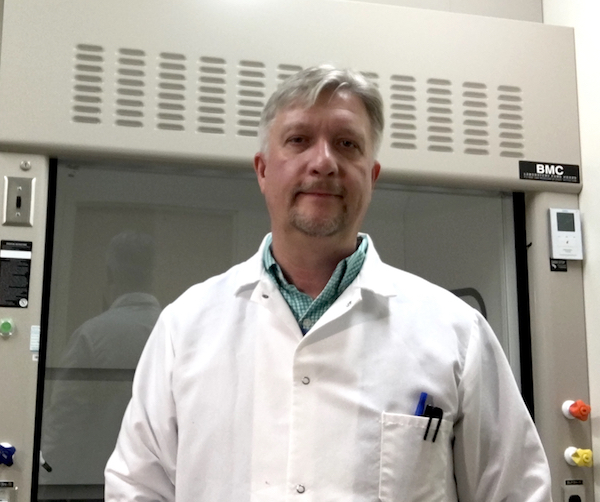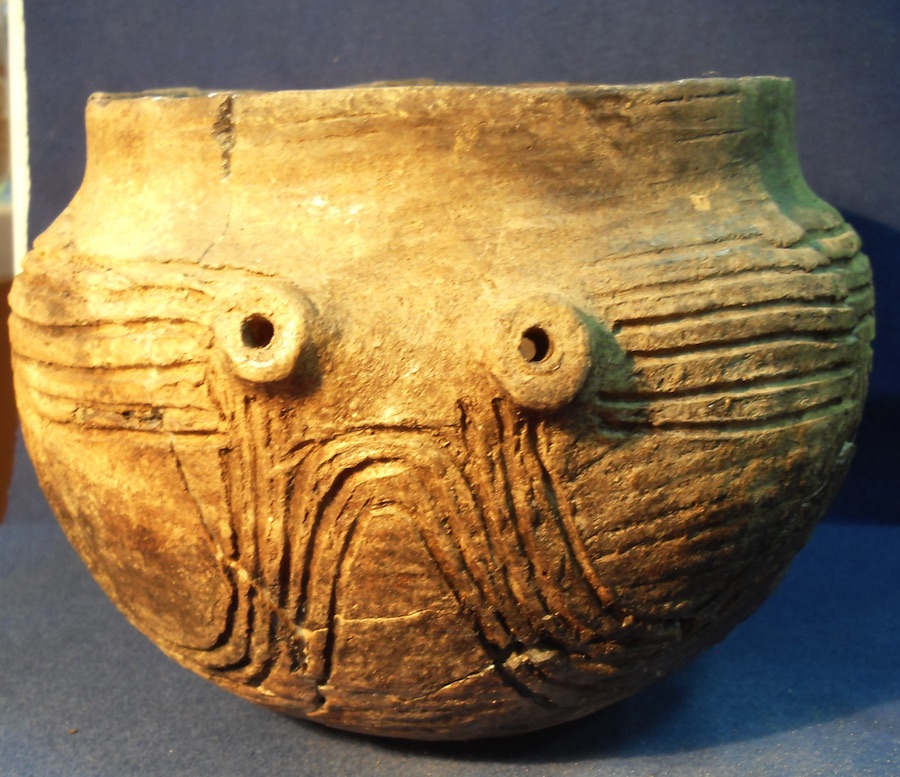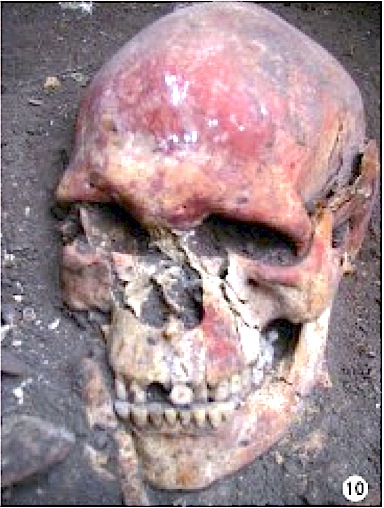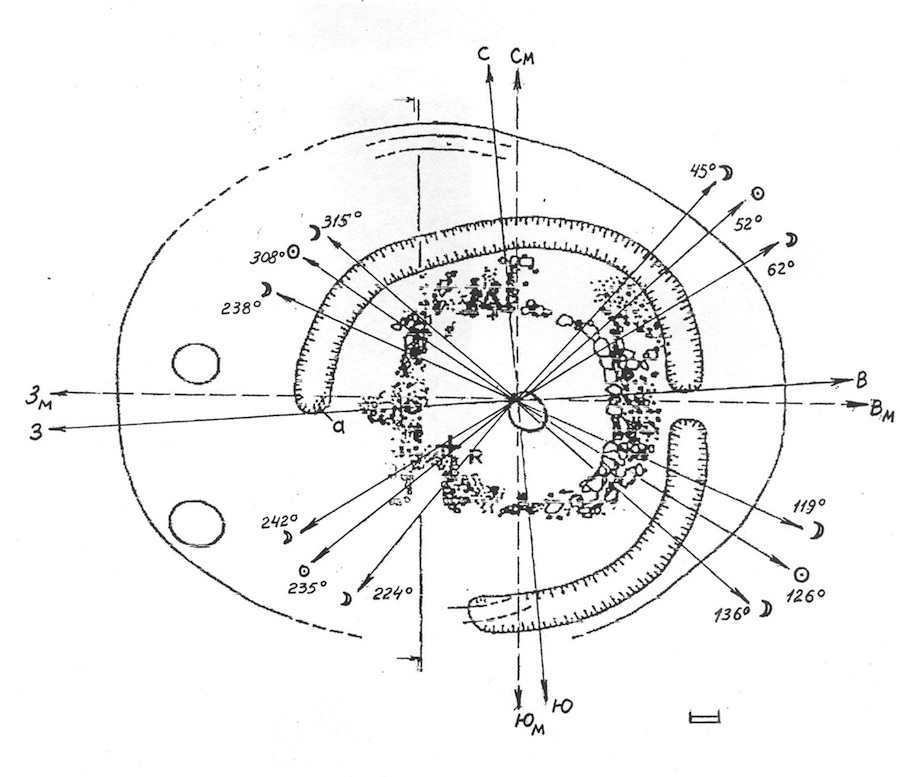Dr.
Alexey G. Nikitin
Professor of Biology
Grand Valley State University,
Allendale, MI 49460

Research interests
Phylogeography,
human evolution, human migrations, molecular archeology
My primary research discipline is
molecular archeology, which is the study of archeological material
using scientific techniques to reconstruct the human past using
fine-scale molecular resolution. Through the analyses of stable and
radioactive isotope composition of material culture artifacts and human
and animal remains, extraction and sequencing of ancient DNA,
biochemical residue analysis of ancient pottery etc., scientists are
able to peek into individual life histories of the people who lived on
this planet before our time.
Our team has been using uniparental
(mtDNA and Y chromosome) markers as well as whole-genome analysis to
trace population affinities of human modern and prehistoric inhabitants
of eastern and southeastern Europe. In addition, we have been refining
radiocarbon measurements of ancient samples as well as studying the
mobility and residence patterns by analyzing strontium and oxygen
isotopes in tooth enamel and diet using isotopes of carbon and
nitrogen.
The current focus of our
investigation is on the prehistoric populations of the northern steppes
of the Black Sea (called the North Pontic Region or NPR) and adjacent
forest-steppe areas. This territory is of great interest to linguists,
archeologists and cultural anthropologists because the NPR is the
apparent source of distinct cultural and genetic determinants, the
former including Indo-European languages and pastoralist economy, that
displaced and replaced the Neolithic agricultural way of life
throughout west Eurasia at the beginning of the Metal Ages. Our team
has been investigating genetic lineages and isotopic signatures of the
NPR inhabitants throughout the Neolithic, Copper, Bronze and early Iron
Ages to uncover both local as well as continent-wide affinities to
examine various models of human population dispersals that accompanied
the shift from the Stone Age to the Metal Ages in Eurasia.

Selected recent publications (2009-current)
2018
Mathieson I, Alpaslan
Roodenberg S, Posth C, Szécsényi-Nagy A, Rohland N,
Mallick S, Olade I, Broomandkhoshbacht N, Cheronet O, Fernandes D,
Ferry M, Gamarra B, González Fortes G, Haak W, Harney E,
Krause-Kyora B, Kucukkalipci I, Michel M, Mittnik A, Nägele K,
Novak M, Oppenheimer J, Patterson N, Pfrengle S, Sirak K, Stewardson K,
Vai S, Alexandrov S, Alt KW, Andreescu R, Antonovic D, Ash A,
Atanassova N, Bacvarov K, Balázs Gusztáv M, Bocherens H,
Bolus M, Boroneanc A, Boyadzhiev Y, Budnik A, Burmaz J, Chohadzhiev S,
Conard NJ, Cottiaux R, Cuka M, Cupillard C, Drucker DG, Elenski N,
Francken M, Galabova B, Ganetovski G, Gely B, Hajdu T, Handzhyiska V,
Harvati K, Higham T, Iliev S, Jankovic I, Karavanic I, Kennett DJ,
Komšo D, Kozak A, Labuda D, Lari M, Lazar C, Leppek M, Leshtakov K, Lo
Vetro D, Los D, Lozanov I, Malina M., Martini F, McSweeney K, Meller H,
Mendušic M, Mirea P, Moiseyev V, Petrova V, Price TD, Simalcsik A,
Sineo L, Šlaus M, Slavchev V, Stanev P, Starovic A, Szeniczey T, Talamo
S, Teschler-Nicola M, Thevenet C, Valchev I, Valentin F, Vasilyev S,
Veljanovska F, Venelinova S, Veselovskaya E, Viola B, Virag C,
Zaninovic J, Zäuner S, Stockhammer PW, Catalano G, Krauß R,
Caramelli D, ZariFa G, Gaydarska B, Lillie M, Nikitin
AG, Potekhina I, Papathanasiou A, Boric D, Bonsall C, Krause J,
Pinhasi R, Reich D. The Genomic History Of Southeastern Europe. Nature 554,
doi:10.1038/nature25778.
2017
Lillie MC, Budd CE, Potekhina I, Price TD, Sokhatsky MP, Nikitin
AG. First isotope analysis and new radiocarbon dating of
Trypillia (Tripolye) farmers from Verteba Cave, Bilche Zolote, Ukraine.
Documenta
Praehistorica, XLIV: 306-324. doi: 10.4312\dp.44.18.
Nikitin
AG, Potekhina I, Rohland N, Mallick S, Reich D, Lillie M.
Mitochondrial DNA analysis of Eneolithic Trypillians from Ukraine
reveals Neolithic farming genetic roots. PLoS ONE
12(2):e0172952. doi: 10.1371/journal.pone.0172952.
Juras A, Krzewinska M, Nikitin
AG, Ehler E, Chylenski M, Aukasik S, Krenz-Niedbala, Sinika V,
Piontek J, Ivanova S, Dabert M, Gotherstrom A. Diverse origin of
mitochondrial lineages in Iron Age Black Sea Scythians. Scientific
Reports doi:10.1038/srep43950.
Nikitin
AG, Ivanova S, Kiosak D, Badgerow J, Pashnick, J. Subdivisions
of haplogroups U and C encompass mitochondrial DNA lineages of
Eneolithic-Early Bronze Age Kurgan populations of western North Pontic
steppe. Journal of Human
Genetics 62: 605-613. doi:10.1038/jhg.2017.12.
2015
Lillie, MC, Potekhina, ID, Nikitin,
AG, Sokhatsky, M. P. First
evidence for interpersonal violence in Ukraine’s Trypillian farming
culture: Individual 3 from Verteba Cave, Bilche Zolote, Ukraine.
In: K.
Gerdau-Radonic, K. McSweeney (Eds.), Trends in Biological Anthropology
1. Oxbow Books: Oxford, pp. 54-60.
2013
Varzari A, Kharkov V, Nikitin
AG, Raicu F, Simonova K, Stephan W, Weiss E, Stepanov V. (2013)
Paleo-Balkan and Slavic contributions to the genetic pool of
Moldavians: Insights from the Y chromosome. PLoS ONE 8(1):
e53731. doi:10.1371/journal.pone.0053731.
2012
Nikitin
AG, Newton JR, Potekhina ID. Mitochondrial haplogroup C in
ancient mitochondrial DNA from Ukraine extends the presence of East
Eurasian genetic lineages in Neolithic Central and Eastern Europe. Journal of Human
Genetics 57: 610-612. doi:10.1038/jhg.2012.69.
Lillie M, Potekhina I, Budd C, Nikitin
AG. Prehistoric
populations of Ukraine: Migration at the later Mesolithic to Neolithic
transition. In: J. Burger, E.
Kaiser und W. Schier (Eds.), Population dynamics in Pre- and Early
History. New Approaches by using Stable Isotopes and Genetics. Berlin,
pp. 79-94.
2011
Nikitin
AG. Bioarcheological analysis of Bronze Age human remains from
the Podillya region of Ukraine. Interdisciplinaria
Archaeologica 2(1): 31-36.
2010
Nikitin
AG, Sokhatsky MP, Kovaliukh MM, Videiko MY. Comprehensive site
chronology and ancient mitochondrial DNA analysis from Verteba Cave -a
Trypillian culture site of Eneolithic Ukraine. Interdisciplinaria
Archaeologica 1(1-2): 9–18.
2009
Nikitin
AG, Kochkin IT, June CM, Willis CM, McBain I, Videiko MY.
Mitochondrial DNA sequence variation in Boyko, Hutsul and Lemko
populations of Carpathian highlands. Human Biology
81(1): 43-58.

Internet publications and unpublished resources
Ivanova SV, Nikitin
AG, Kiosak DV. (2017) Steppe population in Central Europe in the
Early Bronze Age, or the Journey There and Back (Степное
население в Центральной Европе эпохи ранней бронзы, или Путешествие
Туда и Обратно) (Internet publication in Russian,
on Генофонд.РФ)
Summary
The questions of origin,
development and transformation of archaeological cultures are often
associated with the movement of groups of people to new territories.
Special attention is paid by representatives of various sciences to the
Yamnaya culture (YC), since it is with it that a number of researchers
connect the migration of the ancestors of Indo-Europeans to Europe.
Despite the fact that many archaeologists have abandoned the concept of
H. Childe - M. Gimbutas about the Indo-European invasion of the "Kurgan
cultures" to the west, nevertheless, there are adherents of N.Ya.
Murpert viewpont on the development of YC in the Volga-Ural region and
its subsequent distribution to other territories. Based on the
comparison of genomic markers from the remains of representatives of
the Volga-Ural YC and representatives of European populations from the
Mesolithic to the Bronze Age, Western archaeogenetics recently proposed
a variant of the concept of mass migration of the representatives of
this culture from the southern Ural steppes to Central Europe (Haak et
al., 2015).
The analysis of archaeological data with the inclusion of the results
of isotope analysis, allowed us to come to certain conclusions that are
not consistent with this concept. On the one hand, out disagreement
relates to the geographical aspect, which points to the fact that the
alleged migration demonstrates a large-scale migration from one
ecological area (the Eastern European steppe) to another - the forest
zone. Such a drastic change in the economic paradigm is highly
questionable. In addition, in our opinion, the main links are traced
between the European cultures of the Eneolithic - the Early Bronze Age
and the western wing of the Yamnaya Cultural-Historical Community
(YCHC) - mainly with the Budjak (Bugeac) culture of the North-Western
Black Sea region, and not with the Volga-Ural region material, from
where the material for the genetic research of YC came from.
Consequently, the territory from where the Yamnaya population could
have advanced into the Balkan-Carpathian region and, probably, into
Central Europe, should be considered the distribution area of the
Budjak YC.
Artefacts are not always associated with population movements. It would
seem that more specific answers can be given by anthropologists and
geneticists, reconstructing the advancement to other territories of
carriers of a certain anthropological type or genetic variations. But
the findings are quite contradictory, to which attention has already
been paid (Klein 2016, 2017, etc.). The geneticists' data on the
connection of the eastern wing of the YC (Samara "Yamnniki") carriers
with the groups of the Corded Ware culture (CWC) seemed to confirm the
conclusions reached many years ago: it was the migration of the
"Yamniki" to Central and Northern Europe that led to its
Indo-Europeanization and gene pool change. But geneticists neglected to
consider that the YCHC
territory was anything but homogeneous: it is the differences in
material culture that contributed to the designation of individual
local variants within YCHC.
From the point of view of genetics, the common genetic foundation
between the populations of YC and CWC is an established fact. Since the
articles that showed this connection (Allentoft et al., 2015, Haak et
al., 2015, Mathieson et al., 2015), in the discussions of these
results, geneticists and archaeologists have strengthened the idea that
the cause of this connection is the origin of CWC cultures from YC.
This idea developed in parallel with the main idea of mass migration of
YC representatives to Europe (Haak et al., 2015). The problem is that
from the archaeological point of view, neither this mass migration nor
the origin of the CWC from the YC can be traced. Nevertheless, if we
consider that a large-scale migration in question did not take
place, it is still necessary to explain the geneticists' observations
of the similarity in the gene pool of the population of the CWC
popultions of Europe to YC carriers.
According to genetic data, the general genetic element in the YC and
CWC begins to appear in representatives of the Khvalynsk culture from
the southern Urals (Samara) in the Eneolithic (Mathieson et al., 2015).
Prior to its appearance, the genetic basis in the Ponto-Caspian steppe
was the determinants based on the local Mesolithic, mostly similar to
the Eastern Hunter Gathers (EHG) and the cultures that left the burial
grounds of the Mariupol type (Ukraine Mesolithic, UM (Mathieson et al.,
2018) ). At the beginning of the Eneolithic, a new genetic element
appears in the Samara steppe and in the Dnieper Rapids. It is derived
from the Iranian Neolithic farmers with an admixture of the northern
Caucasus hunter-gatherer element (Caucasus Hunter Gatherer, CHG), but
it is not always possible to separate one from another. At the same
time, this element also appears in the south-western Black Sea region
(the eneolithic necropolis of Varna I, 4600-4500 BC, and the necropolis
of the Bronze Age in Mednikarovo, south- eastern Bulgaria, 3000-2900 BC
(Mathieson et al., 2018). At the same time, the genetic element
characterizing the Neolithic farmers of Anatolia and Europe is also
present in the Mednikarovo and the Lower Dnieper (Ozera) Early Bronze
Age (EBA) samples. The origin of the Irano-Caucasus element and the
beginning (and localization) of its appearance in the Ponto-Caspian
steppe remain unclear, but it is clear that this element was present
throughout the entire Western steppe range from Samara to Varna, at
least since the Eneolithic. The appearance of an Anatolian agricultural
element in the EBA population of south-eastern Bulgaria and Ukraine
also remains unclear.
Based on an in-depth archeological and genetic analysis, we propose
that the genetic "invasion" of the Irano-Caucasus genetic element into
Europe at the beginning of the Bronze Age, recently proposed by
paleogenetisits on the basis of large-scale studies of ancient DNA
(Allentoft et al., 2015, Haak et al., 2015), was not the result of a
large-scale migration of representatives of YCHC from the Ponto-Caspian
steppes to Central and Northern Europe, but the result of global
population and cultural changes in Eurasia at the end of the Atlantic
climatic optimum. We further suggest that before the steppe genetics
appeared in Europe at the beginning of the Bronze Age, central European
genetic determinants appeared in the steppe in the Eneolithic, and that
the movement of the steppe genetic element to Europe was at least in
part the second phase of the "pendulum" migration of European
expatriates, returning to the historical area of habitation. We also
come to the conclusion that the very concept of establishing YCHC as a
separate culture is inappropriate, and that groups of nomadic tribes of
the Ponto-Caspian steppe most likely existed as discrete communities in
the Early Bronze Age, although united by a common ideology and a
genetic relationship that included both the Irano-Caucasus (throughout
the entire range), and European/ Anatolian agricultural (locally)
genetic elements.

Works of my late father, Professor
Gennadi A. Nikitin in Theoretical
Physics: A New Look at the Theory of Gravitation (click the
picture)
Contact: nikitin@gvsu.edu
©
Alexey G. Nikitin, 2005-2018





